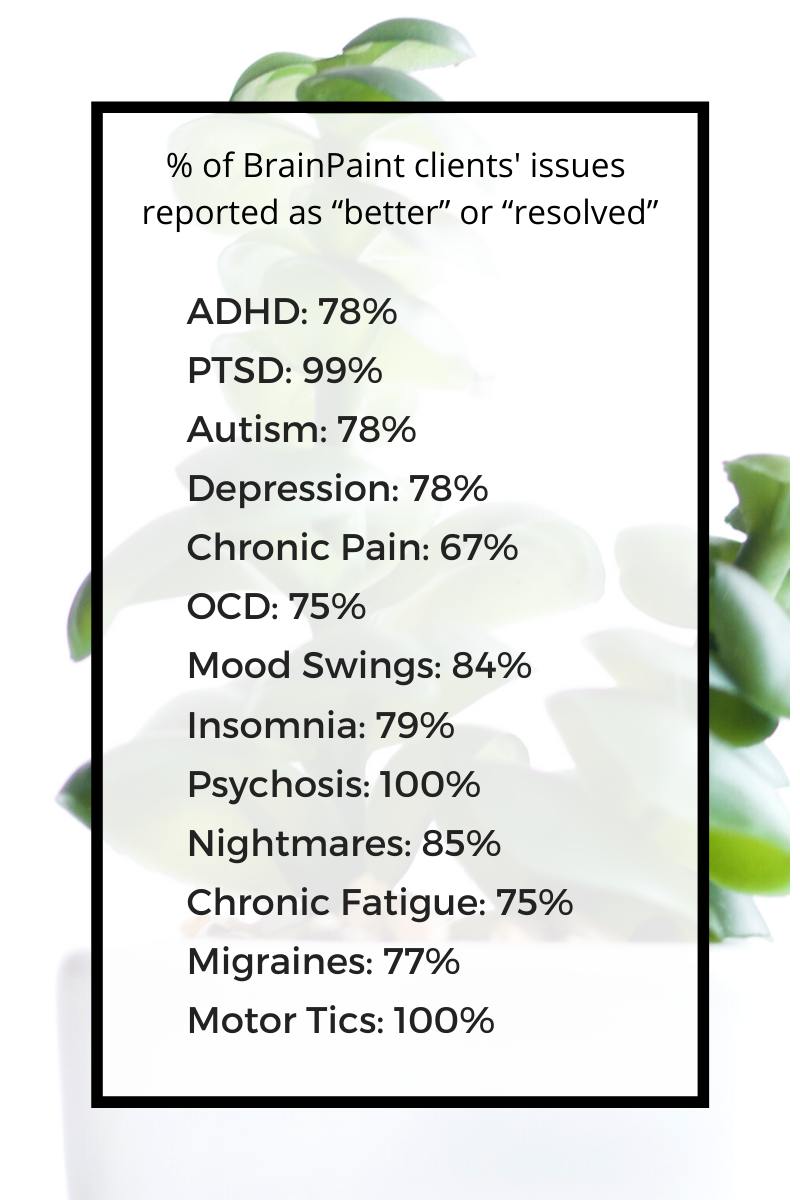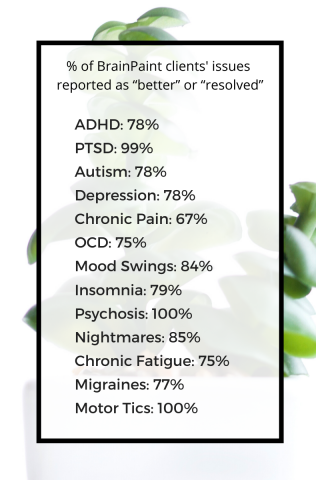
Anmarie is Headache Free after BrainPaint®
Neurofeedback with Kingdom Ministries
Do you struggle with fatigue, insomnia, or negative thought patterns? Is it difficult for you to stay clear and focused? Do you suffer from anxiety or depression? Do you suffer from headaches or migraine, chronic pain or insomnia? Would you like relief from symptoms like these without medications? What if there was a way to heal your brain and teach it to function as it was designed to function?
There is a way to help your brain grow in new ways and even heal some of its current functions—with neurofeedback, a non-invasive therapeutic process. The Kingdom Ministries neurofeedback experience is relaxed, compassionate, and professional.
It’s quite a simple therapy experience for such a complex and challenging feat like retraining the brain! Clients sit in a comfortable chair and focus their attention on moving images on a screen. With this non-invasive technology, the brain learns more about itself from seeing it’s own function, visually (that’s the “feedback” part) and reorganizes and retrains brain signals accordingly! In fifty years of research, no adverse side effects have been associated with BrainPaint®. It is a painless, non-invasive treatment.
Here is what BrainPaint has done for me.
I had gotten use to my headaches. I had seen 5 doctors and 2 nurse practitioners in 13+ years to try and find what was causing them. I had brain scans and a MRI to see if there was something mechanically wrong. There was nothing wrong. The only thing they came up with was stress. The stress came from anxiety. Anxiety was interfering with my health, my sleep and my day to day existence.
A friend had told me about BrainPaint almost 2 years ago. I was more interested in helping my son at the time, so he went first. His grades improved as well as his social skills. His coordination and drive to do well improved too. Next up was my husband, who suffered PTSD from an abusive childhood. What a difference! He is no longer “short fused“! He is calm and more patient with friends and family.
I was next on the list. After 15 sessions I am headache free and sleeping better then I can remember! I don’t stress about things too much either. I can tell my brain to “stop” or think about it later. My quality of life is happier and healthier. No more headache medicine.
The only issue I have with BrainPaint is that I wish I knew about it sooner!
– Anmarie
So, What Exactly is Neurofeedback?
Neurofeedback, also known as EEG (electroencephalogram) biofeedback, is a therapeutic intervention that provides real-time feedback from a computer-based program that assesses a client’s brainwave activity. The program then offers feedback to reorganize or retrain these brain signals. By engaging in this process, a client’s brain function regulates and improves which in turn alleviates symptoms of various neurological and mental health disorders, including depression, attention deficit disorder, anxiety, sleep disorders, headaches and migraines, and emotional issues. It can also be used to help people who have organic brain disorders, such as autism and seizures. Neurofeedback has research backing supporting its noninvasive effectiveness.
Think of your brain as a race car, capable of incredible performance. Now imagine a driver behind the wheel who does not know how to properly shift gears. Brainwave training teaches the brain to work at its fullest capacity; to switch gears as needed for the task at hand.
How does it work?
Neurofeedback is direct training of the brain function, by which the brain learns to function more efficiently. We observe the brain in action from moment to moment. We show that information back to the person and we reward the brain for changing its own activity to more appropriate patterns. This is a gradual learning process that can be applied to any aspect of brain function that we can measure.
Neurofeedback is training in self-regulation. It is referred to as self-regulation because the individual’s brain is learning how to regulate its own brainwave patterns without medication or additional therapy (like cognitive-behavioral therapy for example). Self-regulation is a necessary part of good brain function that allows the central nervous system to function better.
How can watching pictures change my brain?
One thing we get asked a lot is if this therapy will change your mind. It’s important to note that your brain is not your mind. The brain is an organ that processes substantially more information than your mind could handle. For example, it is your brain that regulates an increase in heart rate during physical activity. Would your mind know how to do that? Even though your mind wants to understand and even participate in your EEG Biofeedback session, it is your brain that we are training.
What is a session like?
Step 1: Your provider will ask you a series of standard questions to develop an individualized protocol that will help target your areas of need.
Step 2: Sensors will be put on your ears and scalp. Don’t worry, nothing is sent to your brain, these sensors are ‘read-only’ and will first detect, then visually relay, the electrical activity coming from your brain. This activity is displayed on a screen.
Step 3: Watch moving images on a computer screen that are created from your brain’s activity. Your only ‘job’ is to be mindful of the graphs for 20—30 minutes with breaks every couple minutes.
Can it replace medication?
While under an MD’s supervision, most people can either cut down or stop using their medication after successfully completing the required number of sessions.
How many sessions do I need?
Generally people notice improvements within the first 5—8 sessions. For longer lasting and often permanent results 20—30 sessions are recommended.
BrainPaint® Results
Overall results: 80% of clients report their issues as “better” or “resolved” after 20 sessions. More specifically, the following issues were made “better” or “resolved” by BrainPaint®:

Notes: The BrainPaint® neurofeedback information presented here can be found at www.BrainPaint.com
(BrainPaint Inc., Malibu, California)
Anmarie is a client of Kingdom Ministries’ Kingdom Counseling Center and gave us permission to share her testimony.
Recommended Posts
The Spiritual Significance of this Season
October 30, 2023

